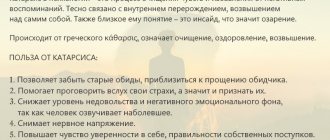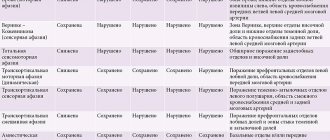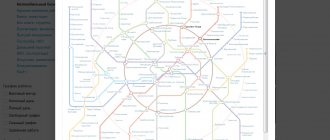In children, speech skills develop gradually until approximately 4 years of age. Some errors in speech are present in children of older preschool age. Over time, with proper communication between the people around them, mistakes in conversation and perception of texts in children disappear.
If a mature person does not understand the written text, can name only a few main words from the information read, does not express his thoughts well, and his speech lacks verbs, prepositions, and conjunctions, he should consult a doctor.
Perhaps the combination of these signs is an expression of a disease called agrammatism. There are several types of deviation. Correct diagnosis can only be made by a qualified doctor after a comprehensive examination.
What is agrammatism? What is paragrammatism? What is dysgrammatism?
Agrammatism is a violation of the ability to use grammatical
structure of speech. Term agrammatism comes from the Greek prefix "a", meaning the absence of a characteristic or quality, and the Greek word grammata, meaning writing, reading. Synonyms for agrammatism are paragrammatism, dysgrammatism. Some patients incorrectly call this disease agramatism.
Classification
Depending on the nature of the disorder (internal or external speech), two types of agrammatism are distinguished in speech therapy practice:
- impressive
– understanding of the meaning of grammatical phrases is impaired; - expressive
– the ability to correctly use case forms, prepositions, and agree on words when speaking independently is not formed or disintegrates.
According to the level of formation of grammatical processes, three degrees of agrammatism are distinguished (from more severe to lighter):
- Speech uses indivisible (one-word) sentences. Composing and repeating detailed phrases causes difficulties.
- Sentences are short, syntactic connections between structural components are broken. Repeated speech suffers.
- Errors in declension of sentence members are noted, otherwise the independent phrase is formed correctly. When repeating a given phrase, no errors occur.
How to treat agrammatism, how to cure agrammatism, how to get rid of agrammatism in Sarklinik?
Sarklinik knows how to treat agrammatism , how to restore the grammatical structure of speech, how to get rid of agrammatism in Saratov. New reflexology treatment methods have helped many of our patients get rid of agrammatism. Effective treatment gives excellent results; patients (children and adults) restore the ability to use the grammatical structure of speech. On our website sarclinic.ru you can see a doctor for free and get a short answer on the treatment of agrammatism.
Sign up for a consultation. There are contraindications. Specialist consultation is required.
Photo: Bds | Dreamstime.com\Dreamstock.ru. The people depicted in the photo are models, do not suffer from the diseases described and/or all similarities are excluded.
Related posts:
Encopresis in children, neurotic encopresis, treatment of encopresis
Neuropathy, childhood nervousness, treatment, nervous child
Sleepwalking in children, adults, treatment, somnambulism, sleepwalking
Enuresis, treatment of enuresis, how to treat nocturnal enuresis in Saratov, Russia
Cerebral palsy in children, children with cerebral palsy, treatment
Comments ()
Diagnostics
Identification of agrammatisms in writing and in oral expression is carried out by a speech therapist-defectologist during a pedagogical examination. To assess the condition of the HMF, a consultation with a neuropsychologist is required. The general diagnostic plan consists of the following stages:
- Diagnostics of oral speech.
Primary attention is paid to examination of vocabulary and grammar. Vocabulary, skills of forming words using prefixes and suffixes, changing words by numbers, gender, and cases are explored. Tasks are given to retell the text, compose a story based on a plot picture and a series of pictures. A comprehensive examination allows us to identify morphological agrammatisms. - Diagnostics of written speech.
Students are taught written work. Students are asked to make sentences using pictures and supporting words, and write a summary. When performing written tasks, as a rule, syntactic and semantic agrammatisms are detected. - Examination for aphasia.
In patients with aphasic disorders, the understanding of speech (questions, instructions) and the ability to speak (automated, repeated, spontaneous speech, naming objects, composing stories) are examined. The ability to write and read is analyzed. The examination may reveal expressive or impressive agrammatism. - Neuropsychological diagnostics.
Within the framework of the neuropsychological approach, an individual’s ability to program, regulate and control a speech act, as well as the peculiarities of processing auditory-verbal and visual-spatial information, are assessed. In the presence of agrammatisms, neurodynamic disorders involved in the organization of speech activity are identified.
Correction of agrammatism
Establishing diagnosis
Correct diagnosis is the result of comprehensive observation and examination. It is very important to determine:
- general condition of a person,
- his psychological and neurological status.
During communication, the specialist evaluates:
- rate of speech;
- variety of syntactic forms used;
- correct use of cases and declensions in speech;
- the presence of unions;
- the presence of prepositions in dialogue and monologue when describing a visual object.
When testing, the number of words and syllables in spoken sentences and the consistency of the endings used are assessed.
To identify disorders of brain activity, it is recommended to do an encephalogram, ultrasound or tomography.
Summarizing and analyzing the information received, the specialist makes a decision to establish a diagnosis.
Rules for correcting speech
A qualified speech therapist teacher, having studied the anamnesis and the conclusions of other specialists, selects the optimal course of classes and the linguistic material appropriate to the case. The operating principles are based on:
- personal orientation;
- creating a favorable emotional environment;
- creating positive motivation;
- interaction with parents.
Without the latter, full, effective pronunciation correction is impossible. Parents should follow the recommendations of the speech therapist and do the exercises.
In some cases, the specialist asks the child's guardians to attend the classes so that they can do simple exercises at home. Because two sessions a week with a speech therapist may not be enough.
Creating a favorable environment and motivation are equally important. Problems can be caused by psychological problems, the overcoming of which falls on the shoulders of a speech therapist.
Personal orientation includes:
- recognition of the child's identity;
- creating situations in which the child could realize his own life experience;
- learning based on situations in which the student wants and can learn.
It is impossible to determine the required number of classes at the beginning of work. It all depends on the individual characteristics of the child and the speed of acquisition of skills and abilities.
Symptoms of motor alalia
⇐ PreviousPage 4 of 5Next ⇒
A) Speech symptoms
The authors, revealing the speech symptoms of motor alalia, talk about a characteristic violation of all subsystems of the language: syntactic, morphological, lexical and phonemic. Typical manifestations of this form of alalia:
- agrammatism, as a violation of the consistency of words in a syntactic structure;
— violation of word search, as a problem of their actualization;
- difficulties in “selecting” phonemes (unrecognizability of the word) and establishing the order of their occurrence; violations of the syllabic structure of words;
- speech negativism, as a refusal to speak.
the manifestations of language symptoms in different children with alalia within a wide range: from the complete absence of expressive speech or the presence in it of only isolated elements of the language system (individual words, sounds, inflections) to minor disturbances in any of the subsystems of the language (in syntactic, morphological, lexical, phonemic). The latter is usually typical only for children of middle and high school age who “come out” or “come out” of alalia. In earlier age periods, as a rule, the entire language system is upset, and the majority of children have the same degree of impairment of all language subsystems (uniform type of impairment); a smaller number have a predominant disorder of one or more language subsystems (uneven type violations).
An indicative point for the symptoms of motor alalia is the inconstancy of symptoms: the same linguistic unit, falling into different conditions, can be correct or incorrect. As for the state of the basic forms of speech, disorders of expressive speech are mandatory and form the core of motor alalia.
A) Violations of the pronunciation side of speech (phonemic, phonetic subsystems of the language, prosody) in children with motor alalia, according to the results of studies by O.V. Pravdina, V.A. Kovshikov, E.F. Sobotovich and others, are very peculiar: pronounced difficulties are noted in the formation of sound images of words. Having a sufficient passive vocabulary, children experience persistent difficulties in naming words. Having sufficient articulatory capabilities (children have access to all non-speech articulations, they cope with the pronunciation of most sounds in isolation), alaliks cannot use these skills when pronouncing speech words. In the pronunciation of sounds o (O.V. Pravdina, 1973).
As a result, in a child with motor alalia, in the absence of paralysis, severe paresis of the articulatory muscles, and with intact hearing, a dynamic articulatory stereotype is not formed; for a long time, speech remains at the level of individual sounds. E.F. Sobotovich clarifies that children do not develop “knowledge” about what set of phonemes denotes this or that semantic concept, therefore, even in the conditions of special training, the speech of children with motor alalia for a long time consists of several onomatopoeias and babbling words.
For scientific clarity, the researchers clarify that some children with motor alalia exhibit dysarthric symptoms, more often than mild ones, that is, minimal dysarthric disorders are possible, but they are not the leading ones in the symptoms of a speech defect.
As a result, children’s speech abounds in:
- literal paraphasias - erroneous, inconsistent, various substitutions, rearrangements of sounds, omissions;
- perseveration - pathological stuckness on a separate sound, syllable, word, caused by a violation of switching from one linguistic unit to another.
Thus, many authors note that when reproducing the sound composition of a word, motor alaliks may experience the following errors: omitting the sounds of the word - “trato” (tractor), baban (drum), assimilating sounds - “polsolnukh” (sunflower); rearrangements, adding extra sounds to words, as a result of which the motor structure of the word even becomes more complicated: “konski” (skates), “vovtsy” (sheep); replacement of some sounds with others: “shubaka” (dog), “mesved” (bear), “tatik” (candy wrapper).
It is characteristic that the replacement of some sounds by others is very diverse, chaotic and unstable, i.e. the same sound can be played differently each time: “zhuk-zuk-lyuh, winter-lima-zhima-nima.” Such instability in the reproduction of the sound composition of a word is not observed with any other defects: with dyslalia, dysarthria, rhinolalia, there is a persistent replacement of some sounds with others that are simpler in biomechanics (p - l, hissing - whistling) or a stable distorted pronunciation of sounds (rhotacism, sigmatism, etc.).
Interestingly, the substitute sound may be more complex in articulation than the replaced sound. All this indicates that children with motor alalia are characterized not by phonetic (articulation) disorders, but by linguistic (phonemic) difficulties - they do not develop a general idea of the phonemic composition of words. Therefore, the words are called differently each time. V.A. Kovshikov notes that phonemic disorders are associated not only with the characteristics of a specific phoneme, not with difficulties in articulating it, but to a greater extent with the contextual influences that the phoneme in a word experiences. These include: sound (phonemic) environment; syllable type; emphasis.
Isolated sounds or syllables can be reproduced without any difficulty. As a result, the work of producing sounds for these children is completely meaningless and even harmful.
Children with motor alalia also experience significant difficulties when reproducing the syllabic structure of a word. According to A.K. Markova, distortions of the syllabic contour: omission of syllables, sounds, their rearrangements, substitutions, are the most numerous among Alaliks compared to all other errors and are persistent.
The most common option is simplification (truncation) of the syllabic structure of a word through the loss of sounds and syllables - elision . For example, “u” is a duck, “lu” is a hand, “uso” is a wheel, “vyrat” is grapes. Most often, the stressed moment of the word is preserved, but in motor alaliks a phenomenon is observed when they pronounce the unstressed part of the word, omitting the stressed part.
The contraction of the syllabic structure of a word is long-lasting and stable in the speech of children with motor alalia. By the age of 4, a normally developing child can master 3-4 complex words. With other speech defects, there are also violations of the syllabic structure of words, for example, with dysarthria. But in dysarthrics, these defects are noted when pronouncing phonetically complex words with a combination of consonants, while in motor alaliks - even when reproducing simple words.
Another characteristic feature of the distortion of the syllabic structure of a word is the assimilation of syllables within the word, as well as the rearrangement of syllables: sidewalk - “tutuar”, cot - “coloring book”. To what has been said, it must be added that mastering the syllabic and sound structure of a word is so difficult for motor learners that it often causes disorganization of the entire sound and syllabic structure of the word, as a result of which they are completely unrecognizable. It is characteristic that not only the independent naming of words is impaired, but also their repetition after the teacher.
The listed violations manifest themselves to a lesser extent when pronouncing local words and to a greater extent when pronouncing words in sentences.
As an illustration, we present examples of word naming by children with motor alalia (age 7 years).
Sample Repetition Independent naming
chair toul toul
cabinet cafe cafe
table stand only
mushroom ip ip
fish iba fish
Difficulties in correctly reproducing the sound and especially the syllabic structure of a word turn out to be very persistent and appear even in children who are significantly advanced in their speech development.
As an illustration, we present some extracts from the protocol of the examination.
Tanya Sh., 10 years old, 3rd grade student at a school for children with severe speech impairments. Tanya speaks conversationally, knows how to construct simple sentences and even compose a short coherent story. A study of sound pronunciation showed that the student, in isolation and in words, can correctly pronounce all sounds, with the exception of the sound p, which is pronounced as a single-stress sound, and the sound z, which is labial for her. Correctly pronounces words that are simple in structure, but when pronouncing more complex words, he makes all the mistakes listed earlier: omission of a sound (“shizhinka” - snowflake, “toebus” - trolleybus), omission and rearrangement of syllables (“aquark” - aquarium; “pever” - bike).
Vita Sh., a 5th grade student at the speech school, speaks relatively well in coherent speech. When independently naming words, he pronounces the word aquarium sequentially as “quaria”, “aquaria”, “aquaria”; when repeating the word university, pronounce it as “uni”, “univer”, “univor”; helicopter - “verto”, “helicopter”; sfetofor - “light”, “seto”, after which he declares that he does not know how to say this word.
Many researchers point out that some motor learners have predominantly difficulties in mastering the sound structure of a word, while others have difficulties in mastering the syllabic composition.
As already noted, with motor alalia, the prosodic side of speech remains relatively intact, but its features due to language disorders are noted. Thus, due to difficulties in finding linguistic units and the rules of their functioning, stops occur, slowdowns, syllable-by-syllable pronunciation of words, prolongation of sounds, and so on. Often, as N.N. Traugott (1940) noted, an alaliki, whose speech is quite expressive, cannot impart the necessary expressiveness to speech on assignment, for example, during dramatization.
· The next block of speech symptoms of motor alalia is violations of the semantic aspect of speech.
A) Lexical violations
Considering lexical violations, S.N. Shakhovskaya, N.S. Zhukova, E.M. Mastyukova, T.B. Filicheva, B.M. Grinshpun, V.A. Kovshikov, E.F. Sobotovich and many other researchers claim that the vocabulary of children with motor alalia develops slowly, distortedly and in terms of quantitative and qualitative indicators does not correspond to the age norm. E.M. Mastyukova notes that the characteristic features of the vocabulary with motor alalia are manifested in two aspects: in the quantitative limitation of the vocabulary - an extremely slow transition of words from the passive to the active vocabulary and in its qualitative disproportion - in a significant predominance of nouns compared to other parts of speech , in particular verbs (1981).
Researchers believe that most of the lexical disorders typical for children with alalia are associated not with the concepts behind the word, but with the process of searching for the word. It is fair to note that narrow horizons and poverty of speech experience lead to limitations in the concepts that children master. Thus, preschoolers with alalia do not know many words: for example, the names of berries, fish, flowers, tools, professions, parts of an object. In a child with motor alalia, the meanings of words in their development do not correspond to age. In some cases, children use words in an overly broad, generalized meaning (for example, calling all fluffy, soft phenomena and objects a cat), and in others, showing too narrow an understanding of the word in relation to a specific object and situation.
E.F. Sobotovich believes that the instability of sound images of words, the difficulty of remembering them and maintaining the syllabic sequence primarily the specific features of the vocabulary of children with motor alalia. The poverty of children's active vocabulary is manifested in the inability to select familiar words from the vocabulary and correctly use them in speech. A typical type of violation is when the same object is called differently in certain situations. For example, helicopter - “tatalet”, “litolot”, “talelet”; winter – “nima”, “mima”, “zhima”.
V.A. Kovshikov clarifies that the difficulties of actualizing words that are familiar to children and are in their passive are explained by the immaturity of phoneme search operations based on semantic (semantic), morphological, sound, rhythmic features, violations of actualization are not directly dependent on the complexity expressed by these words of meaning, from the frequency of words, from the complexity of their syllabic and sound structure.
Evidence of a violation of word search operations is the latent (hidden) period of the child’s reaction (normally - 10 seconds, with speech pathology - more than 40 seconds), due to repeated pauses during answers. Children are often aware of their difficulty finding words, which is confirmed by their attempts to correct incorrect answers or evaluate them (for example, using the answers “no”, “forgot”).
Violations of word actualization cause different forms of errors:
- absence of words (words are not named, the negation “I don’t know” is used);
- replacing words with something:
a) verbal paraphasias - substitutions of words according to semantic, acoustic and morphological variants of similarity. Substitutions based on semantic (meaning) characteristics are the most common. When searching, children address various semantic fields - functional formations, groupings of words based on common semantic features, including the core (the most frequently used words, for example, “dog”) and the periphery (words that are close in meaning, for example, “guards”, “ barks"). In many cases, this addressing is slow, takes roundabout routes, and is limited in the choice of options.
N.V. Serebryakova notes that the organization of semantic fields in children with speech pathology has its own specific features:
- associations are often unmotivated, random in nature;
— for a long time the core of the field and its structure are not identified;
— there is a small volume of semantic fields, which manifests itself in a limited number of semantic connections.
The “immaturity” of semantic fields largely explains the difficulties of finding and updating words in children with motor alalia.
The most frequent substitutions are caused by incorrect choice, confusion of species characteristics (for example, a dove - “this is a titmouse”, a cake - “this is a pie”).
The second place in the number of substitutions is occupied by the mixture of features according to the “part-whole” scheme, when a “part” is replaced by a “whole” (for example, a pocket is a raincoat; cheeks are a face, a head; laces are shoes).
In third place is addressing only based on the “function of the object” (for example, a cloud - “it’s raining”, a stove - “turn on the gas”).
b) It is possible to replace words with verbal descriptions. For example, a brush means “to clean your teeth,” a spinning top means “a cool toy.”
c) Replacement of words with sound pronunciations: typical for children with severe impairment of the language system. For example, an egg – “ko-ko”, a beak – “chick-chick”, a bell – “ding”, wind – “oo-oo-oo”.
d) Replacement of words with facial speech. For example, eyelashes - with your hands you show “like this”, the ceiling - with your hand up “there”.
e) Replacement of words with anomalous (asemantic) words. For example, the ceiling is “blunder”, the feathers are “uzyrs”.
f) Contamination - erroneous reproduction of a word, which is a combination of two or more words. For example, “white” - white and yolk.
Some of the listed forms of errors sometimes appear in combinations: for example, replacement with another word is combined with replacement through facial-gestural speech, description, and onomatopoeia.
N.N. Traugott notes the narrowly situational nature of the vocabulary of children with motor alalia. This is manifested in the fact that they do not immediately begin to use the words learned in the classroom in various situations of verbal communication. At the slightest change in the situation, words that seem to be well known and pronounced in other conditions are lost. The author calls this a symptom of increased inhibition of speech function, i.e. motor alalik only very gradually acquires the ability to freely operate with familiar words, using them without limitation in all situations.
As already noted, the vocabulary of motor alaliks is characterized by the phenomenon of disproportion - the dominance of nouns with a specific objective meaning with a fair shortage of verbs, adjectives, auxiliary parts of speech - prepositions, conjunctions; words of generalizing and abstract concepts. It is curious that the normal ratio of nouns to verbs is 2:1, that is, for every 20 nouns there are 10 verbs.
V.K. Vorobyova carried out an in-depth analysis of lexical-semantic errors characteristic of the speech of children with motor alalia (1967). The author notes that the most common cases are diffuse expansion of the meaning of the verbal dictionary and replacement of an associative nature. Substitutions of a diffuse nature include substitutions when some verbs, previously learned and automated in the active speech of children, acquire an expanded meaning and act as substitutes for missing verbs. Often a diffuse meaning is attached to such a common verb in speech as do
. For example, “Devaska dela itot tlyapka” (The girl makes a flower on a rag. The girl embroiders). “Devaska delut kavat” (Girls make their beds). “Malsik deit kavol” (The boy beats out the carpet).
The verb to do is abstract; it is very broad in its semantics, because it is a pointer to “activity in general.” When an alalik child is asked the question: “Who is drawn in the picture?” - he answers: “Boy,” starting from a specific person. When do you need to answer the question: “What is the boy doing?” - i.e. reveal the content of the picture - the alalik child experiences difficulties because he either forgot this verb or does not know what word denotes this action. And then a situation is created from which a child with normal speech development emerges by answering vaguely: “He is doing something, working.” The alalik child, not operating so quickly with his words and thoughts, instead of a verb with a specific lexical meaning, uses a verb with a general diffuse meaning: “Masik deit katinka.”
Analysis of associative replacements of the name of one action by another showed that three types of replacements are distinguished:
Ø substitutions based on association by similarity: most substitutions are made on the basis of similarity in external characteristics. For example, such replacements as combs - cleans are based on the commonality of similar sounds; embroiders, sews - sews - on the unity of the tool. Substitutions based on the unity of an internal feature (function) are sporadic in nature and are typical for children whose speech is more developed. For example, the replacement pours - puts is based on the unity of the function: both to put and to pour means to place somewhere. This replacement refers to erroneous answers, but it is qualitatively higher than replacements based on the similarity of external features, because follows from the internal connection of verbal words by meaning.
Ø replacements based on association by contiguity: caused by a violation of the spatial or temporal arrangement of phenomena during their reproduction or recall. For example, “Machik vvet iby” (The boy goes into the forest). “Devaka ipakala pato” (Girl cleaning her coat). Substitutions of this type are caused by a shift in the sequence of the act of remembering, which in turn is caused by a decrease in mental activity characteristic of motor alaliks, and mainly by a decrease in active orientation in the process of the act of remembering. In addition, it is necessary to remember the factor of emotionality, which plays a central role in the development of motor speech. Emotionally stronger stimuli come to the fore, inhibiting the rest.
Ø substitutions based on association by contrast: most rare in the speech of alalik children. Substitutions such as pours - pours out , based on the mixing of opposite prefixes in words with the same root, are most typical for children with a higher speech organization.
N.N. Traugott notes that with an increase in vocabulary, the number of grammatical errors in children’s speech does not decrease, as with normal speech development, but increases catastrophically: “... speech is characterized by complete agrammatism: all nouns are in the nominative case, verbs are in the indefinite mood , prepositions and conjunctions are absent.”
· Considering morphological disorders in motor alalia, L.V. Volkova, S.N. Shakhovskaya, N.N. Traugott, V.A. Kovshikov, N.S. Zhukova, E.M. Mastyukova and others note that the formation of grammatical formation occurs with greater difficulties than mastering a dictionary, grammatical categories are not mastered, syntactic structures are primitive. This is due to the fact that grammatical meanings are always more abstract than lexical ones, and the grammatical system of a language is organized on the basis of a larger number of language rules. Children with alalia have impaired mastery of both morphological and syntactic units of language, that is, children have difficulties both in choosing grammatical means for expressing thoughts and in combining them, which, in turn, negatively affects the formation of phrases.
It is worth saying that with normal speech development, the acquisition of grammatical categories begins in the 2nd year of life (at 1.7 - 1.10 months). At the same time, the first verbal combinations appear (the period of sentences from amorphous words - roots). The speech of a child with motor alalia, while remaining poor, is striking in turns unusual for the native language. According to N.N. Traugott, alalik outgrows his speech capabilities: “...the thoughts of a 7-year-old, expressed in the vocabulary of a 2-year-old, determine the originality of the style.”
The lack of formation of the lexico-grammatical structure is manifested in different types of agrammatism. Expressive agrammatism is observed - the inability to change words grammatically correctly and construct sentences in one’s active oral and written speech. Varieties of expressive agrammatism are:
· structural agrammatism – violation of the number and sequence of words in a sentence;
· morphological agrammatism
· semantic agrammatism – incorrect use of words according to their meaning (unjustified expansion of the meaning of a word, the presence of substitutions of an associative nature).
The child’s inability to formulate a thought lexically and grammatically correctly is a consequence of the immaturity of internal speech operations (intention, programming, selection and synthesis of speech material). Mastering the morphological system of language involves a variety of intellectual and speech activities: the child must learn to compare words by meaning and sound (house-home-home), determine their differences, be aware of changes in meaning, identify elements due to which a change in meaning occurs, establish connections between shades of meaning and elements of words (for example, knife - singular, im.p.; knives - plural; knife - singular, tv.p.) (34).
Among motor alaliks, the roots of words and the endings of the original forms remain the most preserved. These elements are deformed only in children with a severe degree of speech underdevelopment, which, according to V.A. Kovshikov, is mainly due to phonemic disorders (for example, a cube - “ku”, a small one - “mya”, sits - “di”).
Prefixes and suffixes are most often subject to violations, their number is extremely limited, and many of those available are used incorrectly.
One of the indicative symptoms of a morphological disorder is incorrect agreement in gender and number: for example, “red dress”, “cars are humming”, “my dad”, “he fell”, “big window”, “beautiful balls”. Errors in the use of endings or numbers are very common (house - “houses”, eye - “eyes”, tree - “trees”).
Errors in the use of case forms are indicative. Most often, children use the “zero” (initial) form - the nominative case, replacing the endings of the oblique cases. With motor alalia, chaotic unstable substitutions of case endings are possible. So, for example, the form of the prepositional case can be replaced by the form Im.p., and Gen.p., and Tv.p., or the correct form can be given.
The picture is similar with the declension of other parts of speech. For example, when agreeing adjectives with nouns, children can give the following options: instead of “no red ball” - “no red ball”; instead of “from an angry dog” - “from an angry dog.”
Many ungrammatical errors are made in verb forms. The most popular form is the infinitive: “mom, dad to drink tea”; "boys throw the ball." Children make many mistakes in the time category. They practically do not use future and past tense verbs, using only present tense verbs.
Motor skills are characterized by persistent errors in word formation, since children do not learn the rules or mechanisms for forming new words. For example, a baby cow is “little mu”; What do you call a table made of wood? - "tree".
Replacement of a verb word with a gesture, stressed part of a word, onomatopoeia, or another verb similar in situation is also observed in children with normal speech development. But such replacements are temporary or accidental in nature and are spontaneously overcome in the course of the child’s further development. In the speech of Alalik children, substitutions are particularly persistent and characteristic combinations and are overcome extremely slowly without correction.
Thus, based on the above data, it is worth noting that researchers do not connect the considered lexical and morphological disorders in alalik children with the pathology of thinking or other mental processes. They are the result of children’s failure to master the system of rules for operating with linguistic units.
The development of the morphological system of a language is closely related to the development of syntax, vocabulary, and phonemic perception.
Focusing on syntactic violations , the results of research by V.K. Vorobyova (1967), revealing the peculiarities of phrase construction in children with motor alalia, are very interesting. The technique she proposed was of a question-and-answer nature: the child was presented with a picture, after examining which, he had to answer two questions: “Who is drawn in the picture?” and “What is he/she doing?” The second question required a complete sentence answer.
Unlike children with normal speech development, an alalik child is attracted to the picture not by the action, but by the objects or the performer of the action. As a result of a decrease in mental activity during the process of looking at a picture, the alalik often “does not see” the action, and therefore the predicative function of speech is not formed. This is confirmed by the form of the noun – nominative case, “Mama vada” (Mom pours water). Answers like “Mama Vadu” are fundamentally different from these answers, since here there is a “vision” of an action with the establishment of relationships between objects, but the name of the action is omitted. It is possible to use a word in addition to a gesture, that is, there is no verb in active speech, but this action is expressed through a gesture, for example, “Machik...” (followed by a gesture indicating that the boy is wiping himself). In addition, there are typical answers that are formed not in separate isolated words, but in a chain of words with two main components - the subject and the predicate. For example, “Mama sot payte” (Mom sews a dress). “Girl...ait” (Girl reading). “Virgin mo...” (The girl washes her hands). From a structural point of view, these responses represent examples of complete two-part sentences. But the qualitative expression of the verb suffers both phonetically and semantically.
Researchers believe that violations of the actualization of words have a negative impact on the syntactic structure of sentences: their omissions, substitutions, which interfere with the construction of constructions and destroy syntactic connections between words.
Various violations of the syllabic and phonemic structure of words characteristic of children with alalia can also lead to syntactic violations. In both the first and second cases, syntactic violations are secondary.
E.F. Sobotovich distinguishes two groups of children with motor alalia:
1. There are violations of the morphological system of the language with relative preservation of the sentence structure (Mom goes with the girl - “Mom goes deka”). Despite the gross morphological agrammatism, the children of this group correctly form sentences of two or three words (The girl was swinging on a swing - “Deca casal caseli”). That is, in this group there is a sharp disproportion between the development of the morphological and syntactic systems of the language.
2. Not only violations of the morphological side of the language are observed, but also the syntactic structure of the sentence. Syntactic violations are most pronounced in all children with alalia at the level of connected text. The degree of their severity is directly dependent on the degree of impairment of the language system.
Considering connected speech as a system of interconnected predicates, it is worth noting that it is built on the basis of internal speech. Investigating the features of coherent speech of children with motor alalia, V.V. Vorobyova (1975), referring to psychological data, emphasizes that coherent speech is contextual speech, since it is understandable to the listener only on the basis of its content, on the basis of the speech context itself . According to N.I. Zhinkin, in any context two groups of objective phenomena can be distinguished: on the one hand, the thoughts themselves, methods of connecting them, types of connections and gaps between them, and on the other, technology, means of consolidating thoughts (1956).
Coherent contextual speech is a complex form of verbal communication, so the child does not master it immediately. Literary sources emphasize that phrasal speech normally develops by about three years of age; coherent speech - by the age of five (not yet developed enough). A five-year-old child correctly constructs individual phrases, but the semantic connections between each other are still imperfect. Genetically contextual speech develops on the basis of situational communication. Gradually, from dialogue, the child moves to forms of coherent speech: to narration (description, explanation, story), and then to reasoning. The highest form of contextual speech is written speech.
For a child to master coherent speech means learning to build a context according to its laws in each specific case. This skill is based on complex analytical and synthetic activity. Analysis is necessary both for the purpose of selecting material for subsequent communication and for the purpose of selecting speech means. The material, the general content of the event, must be decomposed into elements according to a formula - first about this, then about that, etc. Analysis requires an internal process of decomposition, placement of actions, objects, establishment of connections, correlations with each other.
After the analysis, there should be a unification, a synthesis of the selected elements of the situation into a single sequential chain. All this activity is speech, since it predetermines the presence of an internal speech process, which is a step to the external speech act.
It is known that inner speech acts as a planning principle and makes it possible to reduce a detailed utterance to a general semantic scheme - a system of predicates. The predicate system is the dominant link in revealing the sequence of any plot. If any event is represented only by a predicative chain: played - fell - cried, and the subject is not indicated, then the meaning of the event, the logical scheme of the development of the event are clearly manifested, i.e. the ability to imagine and understand the situation using predicates alone remains.
Research by V.A. Kovshikov shows that children with the first level of speech development, having a pronounced deficit of linguistic means and their coherent use, widely use non-verbal means to construct text: sound intonation, gestures, pseudo-word sounds, intonation, facial expressions. These means usually act as a predicate, compensating for their absence.
In children with the second degree (level) of speech development, the structure of the text takes on a more perfect form. The texts are in most cases understandable outside the situation. The central place is occupied by verbal means using predicates. But children's texts convey only the outline of the plot. Individual, often important elements are omitted or rearranged. The structure of the text is disrupted as a result of agrammatism (omissions, incorrect agreement of words), resulting in a misunderstanding of the content.
The texts of many children with the third degree (level) of speech development are close to the norm in content and structure. But they are not developed enough, they lack a creative element. When trying to express temporal and cause-and-effect relationships, children often misuse conjunctions. For example: “Mom told the children because it was going to rain (Mom looked out and said that a cloud was coming).” The semantic side is negatively affected by the problems of actualizing words.
Thus, based on research observations and statements, it should be noted that violations of text construction in most cases are not caused by a disorder of thinking, but by a complex of language disorders. This is confirmed, firstly, by the ability of children to correctly establish the sequence of events through non-speech activity, and secondly, by a comparative analysis of the texts of motor alaliks with the texts of mentally retarded children, whose texts are illogical due to an intellectual defect.
Impairment of impressive speech - impressive agrammatism , as indicated by O.V. Pravdina, L.S. Volkova, S.N. Shakhovskaya, V.A. Kovshikov, is a limited understanding of addressed speech, which is a secondary manifestation of the main defect - underdevelopment of expressive speech . The immaturity of the phonemic system of the language (fuzzy sound perception), the selection of language units, the poverty of vocabulary, the slowness and difficulty of understanding grammatical forms and syntactic structures, and the narrowness of speech practice lead to difficulties for the child to understand the interlocutor’s speech.
In the practice of speech therapy, there are several levels of development of speech understanding :
1) “Zero” : a child with intact hearing does not perceive the speech of others, sometimes reacts to his name, less often to rewards or prohibitions. This level, when the child is “like deaf”, “without depth of understanding”, provokes the speech therapist to scream for perception, to which the child covers his ears and gets scared. Features of this level can also appear in normally developing children, but during infancy.
2) “Situational” : the child understands requests related to the everyday world (“have pity on mom,” “give me a kiss”), knows the names of loved ones, the names of toys, and body parts. At the same time, the baby tends to make mistakes in identifying toys based on verbal descriptions. The child navigates only in a familiar situation and is noticeably lost in a situation with a stranger, with other toys, in a different environment.
3) “Nominative” : the child is well versed in the names of objects and images in pictures, but has difficulty in the names of actions in situational pictures. The child does not understand questions of indirect cases (“What does the bunny draw with?” - the child simply points to the bunny).
4) “Predicative” (verbal): the child knows many names of actions, is oriented in matters of indirect cases, distinguishes the meaning of several prepositions, understands a simple instruction (“Put the book on the table”), following it. But he does not distinguish between modified forms of words (he confuses “where he rides and where he rides”, “where he bathes and where he swims”).
5) “Dismembered” (into morphemes): distinguishes between changes in meanings introduced separately
⇐ Previous4Next ⇒
Recommended pages:
Use the site search:
Correction
Speech therapy classes should begin in parallel with medical measures or immediately after them. Thus, assistance to hearing-impaired children, first of all, should include rational hearing aids and classes with an audiologist. In case of acute stroke resulting in aphasia, comprehensive drug, neuropsychological, physical and speech rehabilitation is required. With tachylalia, a favorable background for speech therapy correction is achieved with the help of physiotherapy, hydrotherapy, and a course of massage. The tactics of speech therapy are determined taking into account the leading syndrome.
Improving grammatical structure
To form the grammatical structure of a language, it is necessary to communicate a lot with the child from early childhood, read high-quality children's literature, and surround him with worthy speech examples to follow. You should not repeat the child’s agrammatisms; you must immediately correct the mistakes made by pronouncing the correct pattern. Grammar games are useful for speech development, helping to automate normative variants of word formation (“One-many”, “Big-small”, “What is missing”, etc.).
OHP correction
Corrective education for children with special needs development disorders is carried out in specialized speech therapy groups of preschool educational institutions, starting from the age of 4. Agrammatism must be overcome by the start of school. In classes, a speech therapist clarifies and expands children's vocabulary, develops understanding of speech, develops skills in inflection, word formation, and the use of simple common and complex sentences. As lexical and grammatical means improve, coherent speech develops, the ability to compose a story and retell what is heard is formed.
At the same time, phonetic gaps, phonemic underdevelopment, and violations of syllabic structure are eliminated. The preparatory group works on developing basic reading and writing skills. During classes they use physical education exercises, articulation gymnastics, phonetic rhythms, exercises for the development of fine motor skills, and, if indicated, speech therapy massage.
Dysgraphia correction
Since written agrammatisms are a consequence of general speech underdevelopment, their correction is carried out in the same basic directions. Additional attention in classes is paid to the study of the morphological composition of words and the syntactic structure of sentences. The consolidation of grammatical norms and rules is carried out not only in oral, but also in written exercises.
Rehabilitation work for aphasia
Different types of aphasic disorders require a differentiated approach to speech rehabilitation. To eliminate impressive agrammatism in semantic aphasia, work is being done to overcome disturbances in spatial perception and restore understanding of logical-grammatical structures. With sensory aphasia, the patient is taught to understand situational speech, differentiate phonemes, and formulate phrases grammatically correctly.
After disinhibition of oral speech, patients with motor aphasia move on to developing correct articulatory postures and switches, overcoming grammatical distortions (composing detailed sentences, correct use of prepositions and conjunctions, etc.), restoring reading and writing.
The main task for dynamic aphasia is to stimulate speech activity, train in word inflection, and construct phrases of various syntactic models. In order to overcome agrammatism in patients with acoustic-mnestic aphasia, work is being done to expand auditory-speech memory and compose complex sentences.
You can anticipate trouble
To prevent the appearance of agrammatism, the normal neonatal period of the child’s formation is very important.
Neurological disorders of the unborn child can develop during a difficult pregnancy, aggravated by infectious or other diseases. A correct lifestyle and regular observation by an attentive doctor of the expectant mother is the key to the birth of a healthy baby.
Abnormalities in the functioning of brain cells can appear in adults due to past illnesses and circulatory disorders. A preventive measure is a careful attitude to one’s own state of health, the use of general strengthening procedures in everyday practice, and the formation of healthy lifestyle habits.
The condition of patients with agrammatism can be significantly improved, up to complete recovery. Successful treatment is possible with timely consultation with specialists and strict adherence to the doctor’s recommendations.









